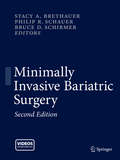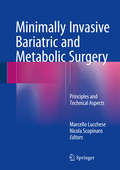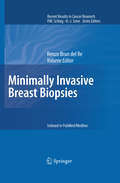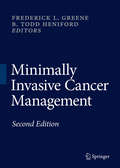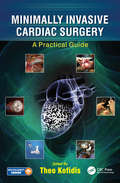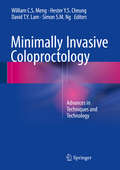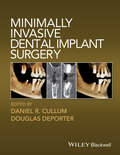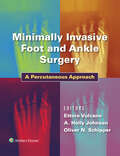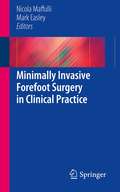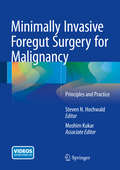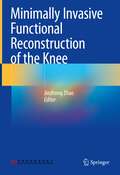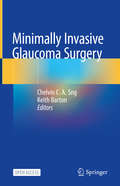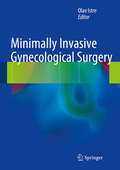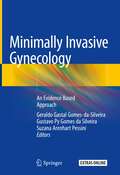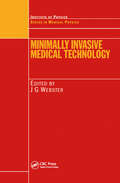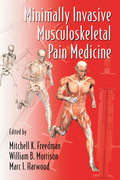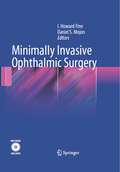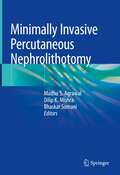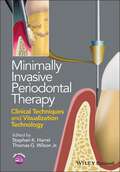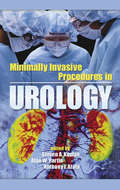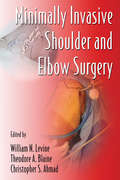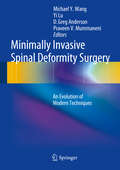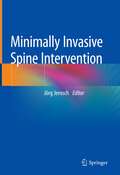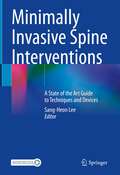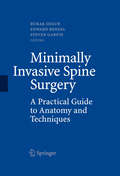- Table View
- List View
Minimally Invasive Bariatric Surgery
by Stacy A. Brethauer Philip R. Schauer Bruce D. SchirmerThe second edition of Minimally Invasive Bariatric Surgery provides a comprehensive, state-of-the art review of this field, and it serves as a valuable resource for clinicians, surgeons and researchers with an interest in minimally invasive bariatric surgery. Additionally, the second edition includes new features that will benefit the resident, fellow, or bariatric surgeon new to the field. Specifically, each evidence-based chapter (i. e. outcomes, complications, epidemiology, etc) concludes with three or four exam questions that emphasize the salient points of the chapter and provide fellowship programs a valuable training tool and resource for their academic curriculum. These questions are either single-answer multiple choice or true/false format and the correct response with a brief explanation follows. As more emphasis is placed on completing a comprehensive curriculum and obtaining certification for bariatric training, this aspect of the book is unique and provides added value to the text. The new edition also incorporates many new or updated medical illustrations to enhance the technique chapters and provide more uniformity for the artwork throughout the book. Each of the major procedures include surgical technique, outcomes, and management of complications in separate chapters to provide an easy reference for the busy clinician preparing for a case or presentation. Another unique feature of the text is a link to video files hosted online for the relevant chapters. This video library will be of great value to the user. As the number of fellowships in laparoscopic bariatric surgery continues to increase, this updated text will provide a valuable resource for general and bariatric surgeons, laparoscopic surgeons, fellows, residents, medical students, obesity researchers, and industry representatives involved in this field.
Minimally Invasive Bariatric and Metabolic Surgery
by Marcello Lucchese Nicola ScopinaroThis book explains the concept of metabolic surgery and provides step-by-step descriptions of all the principal minimally invasive surgical techniques employed to treat morbid obesity. The approach adopted is very practical. For each procedure, indications, technical aspects, clinical management and outcomes are described and helpful tips and tricks, highlighted. Guidance is provided on the management of emergencies and potential complications, as well as on general postoperative management and long-term follow-up. The coverage also includes new frontiers of robotic and endoscopic surgery. While the focus is on surgical techniques, emphasis is placed on the need for a multidisciplinary approach, with explanation of the role of the multidisciplinary team and the bariatric center. In addition, important information is presented on the definition of morbid and severe obesity, incidence/prevalence, pathophysiology and obesity-related comorbidities. The authors are internationally acknowledged experts who present best practice know-how in the field and draw on the most recent research literature.
Minimally Invasive Breast Biopsies
by Renzo Brun del ReModern imaging methods have made it possible to detect breast cancer at an earlier stage than in the past. Nevertheless, a large majority of suspicious findings at screening subsequently prove to be benign. It is therefore important to be able to identify benign lesions in a manner that is reliable, tissue sparing, patient friendly, and cost-effective. More than 70% of breast biopsies can now be performed using minimally invasive procedures that meet these criteria. This book examines in detail vacuum-assisted minimally invasive breast biopsy systems (ATEC, EnCor, Intact, Mammotome and Vacora), stereotactic systems, MRI-guided procedures, and ductoscopy. Further chapters are devoted to the pathology of the breast tissue obtained using these procedures, their limitations, the implications of recent advances in breast imaging, and the results of cost-benefit analyses. The closing chapter provides a systematic review and meta-analysis of recent data.
Minimally Invasive Cancer Management
by Frederick L. Greene B. Todd HenifordAs minimal access approaches to cancer diagnosis, staging, and therapy become more widely used, it is vital for general surgeons, along with laparoscopists, surgical oncologists and medical oncologists, to stay up to date. The editors, a team consisting of a renowned surgical oncologist and a laparoscopic specialist, aim to provide a resource for the practicing general surgeon using basic minimally invasive techniques. The book discusses diagnosis including biopsy with microinstrumentation, staging, and palliative and curative resection. Specific tumor sites are addressed, including esophagus, stomach, spleen, small bowel, pancreato-biliary, hepatic resection, and colo-rectal resection. Minimally invasive approaches to the thoracic and retroperitoneal areas are included. The book provides a thorough overview of basic cancer biology, instrumentation, and ultrasound. Additionally, Greene and Heniford explore controversial issues such as port-site recurrence and the effect of pneumoperitoneum on the spread of cancer cells in the abdomen. Many photographs and line drawings, including 16 in full color, illustrate the principles discussed in the text. A must-have for every practicing general surgeon, laparoscopic fellow, and general surgery resident.
Minimally Invasive Cardiac Surgery: A Practical Guide
by Theo KofidisMinimally invasive cardiac surgery(MICS) is an integral component of every future cardiac surgeon’s training. There continues to be a growing global demand towards less invasive surgical techniques. Both cardiologist and cardiac surgeon form "heart teams" to provide patients with novel, minimally invasive procedures, with all their benefits. Less invasive techniques are often complex and require special knowhow and skills. This book offers an innovative approach to learning, utilizing QR code technology, which refers the reader to essential audio-visual material, which, along with the didactic text, focuses on practical aspects of minimally invasive cardiac surgery. In modern Heart Teams, and with the advent of the hybrid era, surgeons will only be able to survive if they have state-of-the-art skills in less invasive technologies, which can be incorporated in the hybrid theatre and/or trans-catheter arena. This text accompanies the surgeon along this path, and provides clinical advice and practical solutions, beyond the necessary basic knowledge. Which courses to visit, which videos to watch, which centres to join for serious training? How best to exploit public and multimedia? How to consent a patient into a MICS procedure? How to set up a MICS program or practice? In the era of value driven outcomes, and a shift towards shorter and better patient journeys, MICS is a skill that no heart surgeon can be without. Minimally Invasive Cardiac Surgery: A Practical Guide is a teaching resource, reference book and manual written by surgeons who both operate and teach the procedures described within. Provides access to online resources via QR codes Includes links to videos and the e-version of the text Acts as a gateway to a huge choice of minimally invasive cardiac surgery materials
Minimally Invasive Coloproctology
by William C. S. Meng Hester Y. S. Cheung David T. Y. Lam Simon S. M. NgIn this book, pioneers and distinguished masters of surgery describe novel minimally invasive colo- and anorectal procedures that have been developed in Asia but are of international applicability. The presented techniques are wide ranging in nature and relate to colon surgery, rectal surgery and the treatment of hemorrhoids, fistulas and chronic constipation. Each procedure is carefully described with the aid of high-quality color photographs and illustrations, drawing attention to many practical tips and tricks. In addition to the techniques themselves, state of the art technology is introduced that is now being applied clinically in China, Hong Kong, Asia-Pacific, and beyond. The book will enable readers both to grasp the concepts underlying these important new approaches and advances and to reproduce the techniques in their own surgical practice.
Minimally Invasive Dental Implant Surgery
by Daniel R. Cullum Douglas DeporterMinimally Invasive Dental Implant Surgery presents a new clinical text and atlas focused on cutting edge and rapidly developing, minimally invasive treatment modalities and their applications to implant dentistry. Centered on progress in imaging, instrumentation, biomaterials and techniques, this book discusses both the "how to" as well as the "why" behind the concept of minimally invasive applications in implant surgery. Drawing together key specialists for each topic, the book provides readers with guidance for a broad spectrum of procedures, and coalesces information on the available technologies into one useful resource. Minimally Invasive Dental Implant Surgery will be a useful new guide to implant specialists and restorative dentists seeking to refine their clinical expertise and minimize risk for their patients.
Minimally Invasive Foot and Ankle Surgery: A Percutaneous Approach
by Holly Johnson Ettore Vulcano Oliver SchipperWritten by leading global experts in this rapidly growing field, Minimally Invasive Foot and Ankle Surgery: A Percutaneous Approach, edited by Ettore Vulcano, MD, A. Holly Johnson, MD, and Oliver N. Schipper, MD, covers all aspects of minimally invasive surgery (MIS) for today’s foot and ankle surgeons. In one highly illustrated, easy-to-follow reference, this cutting-edge text provides practical guidance on the recent advances in technology and techniques that allow for keyhole incisions, lower risk of infection, less pain, and shorter postoperative recovery times. The authors’ years of experience as pioneers of modern MIS foot and ankle surgery in North America ensure that this new reference will become your go-to resource for improved outcomes and fewer complications using today’s best keyhole surgery techniques.
Minimally Invasive Forefoot Surgery in Clinical Practice
by Mark Easley Nicola MaffuliWith this proliferation of arthroscopy and other minimally invasive approaches due to the greater demands for day case surgery, there is much interest among orthopedic surgeons for quick reference guides to assist with minimally invasive techniques. Describing the techniques and, importantly, the indications for minimally invasive procedures for the management of forefoot disorders, this book will explain the management of various conditions and how they can be approached using minimally invasive techniques. However, rather than only concentrating on minimally invasive surgery of the forefoot, the book will examin the options open to surgeons operating in this area - both open surgical and arthroscopic - and explaining the benefits of each. Extensive radiographs, diagrams, and intra-operative pictures will illustrate the procedures described.
Minimally Invasive Foregut Surgery for Malignancy
by Steven N. Hochwald Moshim KukarThis book provides detailed, comprehensive and illustrative content to the surgical community in the areas of foregut oncologic surgery. The text contains an in depth review of all surgical aspects of oncologic diseases involving the stomach and esophagus. The main focus is on the minimally invasive techniques including potential complications and their management. The text also includes an online link for the videos for all minimally invasive foregut surgical procedures including animation content which provide a more comprehensive learning experience. Minimally Invasive Foregut Surgery for Malignancy: Principles and Practice is structured in a way that makes it useful at every level of training and will be of great utility to practicing surgeons, fellows in surgical subspecialty training and surgical residents.
Minimally Invasive Functional Reconstruction of the Knee
by Jinzhong ZhaoThe book provides essential surgical techniques to restore knee function, in addition to the anatomical reconstruction. It introduces 44 techniques in separated chapters, which are composized with the same text structure and high-resolution photos. The authors are good at managing and teaching these techniques. The step-by-step descriptions and illustrations are very helpful for the readers of orthopaedic and sports medicine surgeons.
Minimally Invasive Glaucoma Surgery
by Chelvin C. A. Sng Keith BartonThis open access book covers all aspects of minimally invasive glaucoma surgery (MIGS) and provides detailed information on each MIGS device, including its mechanism of action; patient selection; implantation techniques; post-operative management; and a review of the existing literature. Step-by-step descriptions are provided for the surgical technique used in implanting each MIGS device, accompanied by clear photographs of each surgical stage. Other areas covered include intra-operative gonioscopy (with tips on optimising the view of the anterior chamber angle) and the management of the intra-operative and post-operative complications. Essential information on the anatomy and physiology of the different aqueous outflow pathways is also included. A separate chapter addresses the introduction of MIGS globally, including the consideration of different reimbursement environments and the different types of glaucoma, e.g. angle closure glaucoma. This book will assist both glaucoma surgeons and general ophthalmologists in overcoming the learning curve involved in performed MIGS, by providing valuable and practical clinical pearls
Minimally Invasive Gynecological Surgery
by Olav IstreIn this book, world-renowned experts describe the latest advances in minimally invasive gynecologic surgery and explain why endoscopy is of key importance in so many conditions. Hysteroscopic instrumentation is described and the application of hysteroscopic techniques in patients with polyps, fibroids, malformations and infertility is explained and evaluated. Individual chapters are devoted to the current minimally invasive treatment of endometriosis, endometrial polyps and adenomyosis. The role of laparoscopy in gynecologic oncology and the laparoscopic approach to hysterectomy are fully discussed. Various other applications of laparoscopy are considered, with coverage of techniques including traditional straight stick laparoscopy, barbed suture and robotic and single port surgery. Neurophysiology and the use of laparoscopic therapy to restore vital function are discussed and complications of laparoscopic surgery are also addressed.
Minimally Invasive Gynecology: An Evidence Based Approach
by Geraldo Gastal Gomes-da-Silveira Suzana Arenhart Pessini Gustavo Py da SilveiraIn the last 25 years, minimally invasive surgery techniques have had a great impact on all gynecologic surgery areas, becoming the technique of choice in most leading health centers around the world. Nowadays, due to such developments, the employment of minimally invasive techniques is a feature for every gynecological surgery service, being part of their daily routine. To the same extent, it is a requirement for every gynecological surgeon to be aware and up to date regarding these techniques and their uses. The book describes and discusses minimally invasive techniques in gynecological surgery by means of an evidence-based analysis, providing clinical correlations for a practical purpose. Techniques covered include vaginal radical trachelectomy, laparoscopic radical hysterectomy, robotic surgery in gynecological cancer, hysteroscopic myomectomy, LESS surgery, deep endometriosis surgery, and laparoscopic supra cervical hysterectomy. Some of the most renowned international references in minimally invasive surgery are included in this title, making Minimally Invasive Gynecology: an Evidence Based Approach fundamental reading for all gynecologists and gynecological surgeons.
Minimally Invasive Medical Technology
by John G. WebsterMinimally invasive medicine has the goal of providing health care with minimal trauma. When minimally invasive surgery is utilized, it reduces the length of hospital stays, lowers costs, lowers pain, and reduces blood loss. Other minimally invasive techniques minimize radiation exposure, tissue damage, and drug side effects. Collecting cont
Minimally Invasive Musculoskeletal Pain Medicine (Minimally Invasive Procedures in Orthopaedic Surgery)
by William B. Morrison Marc I. Harwood Mitchell K. FreedmanAn all-encompassing reference on the diagnosis and treatment of painful musculoskeletal conditions, this source examines the latest developments, therapies, and treatments for common and complex pain disorders affecting the spine, joints, neck, and related structures. Exploring a wide variety of treatment regimens and procedures, including the use
Minimally Invasive Ophthalmic Surgery
by I. Howard Fine Daniel MojonMany minimally invasive procedures have been developed over the past decades, leading to a great improvement in eye surgery. This unique textbook and reference guide provides a complete up-to-date overview of minimally invasive surgical techniques in ophthalmology. Lavishly illustrated with superb illustrations and video clips, it presents the state of the art of minimally invasive ophthalmic procedures. It serves as an invaluable resource for all ophthalmic surgeons with widely varying levels of experience, from the resident to the experienced surgeon.
Minimally Invasive Percutaneous Nephrolithotomy
by Madhu S. Agrawal Dilip K. Mishra Bhaskar SomaniUrolithiasis is a common and ever-increasing problem all over the world. During the last few decades, percutaneous nephrolithotomy (PCNL) has become the preferred treatment method for moderate and large volume upper tract urinary calculi. In recent years, there have been groundbreaking advances in the field of percutaneous renal surgery in the form of minimally invasive percutaneous nephrolithotomy. Various techniques have been described over the years in the area, which have improved the results of percutaneous nephrolithotomy surgery while reducing the complication rate and morbidity. This book provides a broad, state-of-the-art review in the field of minimally-invasive percutaneous nephrolithotomy. It serves as a valuable resource for Urologists, endourology fellows, and researchers interested in mini-percutaneous nephrolithotomy. The book reviews the latest data about percutaneous management of Urolithiasis from the world over, various classification systems for mini-percutaneous nephrolithotomy, armamentarium, different techniques, and multiple advances, plus the results including complications. This book serves as a valuable resource for urologists dealing with and interested in learning the newer advances in percutaneous renal surgery. It delivers a comprehensive summary of the current status of minimally-invasive percutaneous nephrolithotomy in the management of Urolithiasis. All the chapters have been written by experts in minimally invasive percutaneous nephrolithotomy and present the most recent scientific data.
Minimally Invasive Periodontal Therapy
by Thomas G. Wilson Jr. Stephen K. HarrelThe long-term success of periodontal therapy is dependent on proper diagnosis and removal of subgingival tooth-borne accretions in the form of calculus and bacteria. From a clinical perspective, better visualization during the diagnostic and therapeutic phases has been shown to yield better results compared to traditional approaches.Minimally Invasive Periodontal Therapy evaluates the advantages of using minimal invasive techniques, the technologies available for enhancing visualization during minimally invasive therapy, and step-by-step illustrates the clinical use of each technique. Each chapter addresses the advantages and disadvantages of minimally invasive therapies, rationale for the approach, and the advantages and limitations of each of the current methods of improving visualization. The chapters then provide an evidence-based review of the technologies and procedures, and end with case studies for each visualization procedure, featuring clinical photographs.
Minimally Invasive Procedures in Urology
by Steven A. Kaplan Alan W. Partin Anthony J. AtalaCombining the clinical expertise of internationally renowned specialists with the latest research and surgical techniques, this detailed reference guides the reader through the wide range of applications for minimally invasive surgery in urology, as well as the many diagnostic and therapeutic procedures utilizing minimally invasive technologies.
Minimally Invasive Shoulder and Elbow Surgery
by Christopher S. Ahmad William N. Levine Theodore A. BlaineA representation of the skills and expertise of leading surgeons in the field, this reference serves as a step-by-step instructional resource on arthroscopic and minimally invasive surgery of the shoulder and elbow. With full-color illustrations throughout, each chapter focuses on specific techniques and will contain strategies to enhance recovery,
Minimally Invasive Spinal Deformity Surgery
by Yi Lu Michael Y. Wang D. Greg Anderson Praveen V. MummaneniContemporary spinal surgeons, whether orthopedic or neurosurgeons, are increasingly recognizing minimally invasive spine surgery (MISS) as a desirable option to manage advanced degenerative diseases. MISS techniques minimize blood loss, surgical site pain, and speed recovery. Thus, the marriage of MISS with adult spinal deformity was a natural one. Currently, the techniques, technologies, and education of surgeons have finally reached a point where MISS deformity surgeries are becoming commonplace. Nevertheless, the field is young enough that no comprehensive texts have addressed the unique challenges faced by surgeons exploring this evolving field. This book will fill the gap.
Minimally Invasive Spine Intervention
by Jörg JeroschThe expert knowledge on numerous established and innovative minimally invasive interventions on the spine is systematically and in detail summarized in this book. All chapters are consistently structured with special education, implementation of the intervention, complications, literature, reimbursement and a final conclusion with assessment of clinical relevance. The focus is on the practice: step-by-step the procedure is presented under the heading "carrying out the intervention". The book is ideal for practitioners who want to benefit from the know-how of experienced colleagues or who are interested in new innovative procedures and for referring physicians who want to get an overview.This book is a translation of the original German 1st edition Minimalinvasive Wirbelsäulenintervention by Jerosch Jörg published by Springer-Verlag GmbH Germany, part of Springer Nature in 2019. The translation was done with the help of artificial intelligence (machine translation by the service DeepL.com). A subsequent human revision was done primarily in terms of content, so that the book will read stylistically differently from a conventional translation. Springer Nature works continuously to further the development of tools for the production of books and on the related technologies to support the authors.
Minimally Invasive Spine Interventions: A State of the Art Guide to Techniques and Devices
by Sang-Heon LeeThis book is an up-to-date guide to the techniques and devices that may be used when performing minimally invasive spine interventions. The indications for such procedures, which offer various advantages over open surgery, continue to expand, and the aim of the book is to equip spine interventionists with the knowledge required in order to achieve optimal clinical outcomes consistently. After discussion of all aspects of patient preparation, conventional minimally invasive procedures for disorders of the cervical, thoracic, lumbar, and sacral spine are thoroughly reviewed. Attention then turns to more advanced techniques and devices, including percutaneous epidural neurolysis, foraminoplasty, the L’DISQ device for disc decompression, transforaminal epiduroscopic laser annuloplasty (TELA), trans-sacral endoscopic laser decompression (SELD), percutaneous endoscopic lumbar discectomy (PELD), and minimally invasive lumbar decompression (MILD). In addition to full description and illustration of treatment methods, guidance is provided on indications, contraindications, potential complications, and postoperative care.
Minimally Invasive Spine Surgery
by Edward Benzel Steven Garfin Burak OzgurMinimally Invasive Spine Surgery is a beautifully illustrated atlas describing the 18 most widely accepted minimally invasive procedures in spine surgery. Written by leaders in both neurologic and orthopedic spine surgery, this book offers the most up-to-date material and the broadest perspective on the subject. Procedures range from simple to complex and cover the cervical, thoracic and lumbar regions of the spine.
